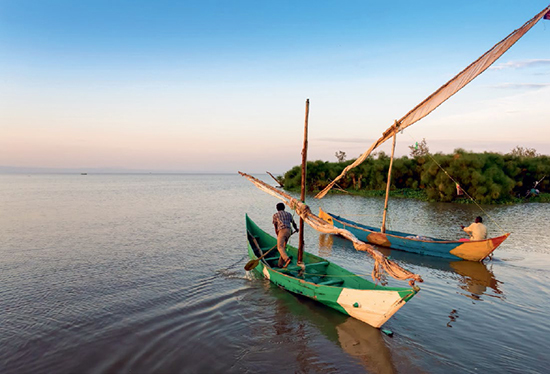c. 400,000 BCE
Lake Victoria
By definition, rift valleys such as the East African rift zone are regions where continental crust is being torn apart. Rifting apart of continental plates occurs over a wide zone of faulting or cracking of the continental crust, in linear zones perpendicular to the direction of the opening rift. In East Africa, like in Death Valley and other parts of the Basin and Range region of the North American plate, crustal blocks between parallel, nearly vertical normal faults can drop down along those faults, forming basins or valleys called graben.
Because of the wet, tropical climate of much of the East African rift zone, Africa’s largest freshwater lake, Lake Victoria, has formed within one of these graben regions. Bounded by Kenya, Tanzania, and Uganda, Lake Victoria is the largest tropical lake in the world, and the second-largest freshwater lake overall (second only to Lake Superior within the Great Lakes of North America). A leading hypothesis for the formation of Lake Victoria is that ongoing rifting starting about 400,000 years ago caused uplifted crustal blocks (horst ridges, to geologists) to dam rivers that had previously been freely flowing across the plains, leading to the accumulation of large volumes of water in the adjacent down-dropped graben valley. Today, only one river drains Lake Victoria: the mighty Nile.
There is ample fossil and geologic evidence that Lake Victoria has completely dried up multiple times since it formed, most likely because of a dwindling supply of snowmelt and precipitation during peak Ice Age periods. As the climate has warmed between the Ice Ages, however, the Lake has refilled—most recently after the end of the latest ice age around 11,000 years ago. Over that relatively short period of geologic time, Lake Victoria has been repopulated at an astonishing rate by a rich diversity of fish, reptiles, mammals, plants, and other species that have thrived in the tropical environment. Unfortunately, as with many inland lakes around the world, overfishing and poor environmental stewardship of the lake’s ecosystem (pollution, development, and so forth) have led to the human-caused extinction of many of those species, as well as the proliferation of many non-native invasive species.
SEE ALSO East African Rift Zone (c. 30 Million BCE), The Dead Sea (c. 3 Million BCE), Death Valley (c. 2 Million BCE), End of the Last “Ice Age” (c. 10,000 BCE), The Great Lakes (c. 8000 BCE), Controlling the Nile (1902)
Fishermen heading out to work along the shores of Lake Victoria in Uganda.
